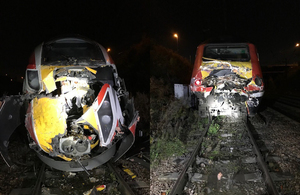Report 13/2020: Collision and derailment at Neville Hill
RAIB has today released its report into the collision and derailment at Neville Hill, 13 November 2019.

Photograph of the class 800 train (left) and HST set (right) involved in the accident (images courtesy of Network Rail)
Summary
At 21:41 hrs on 13 November 2019, an empty LNER Intercity Express Train, approaching the maintenance depot at Neville Hill in Leeds, caught up and collided with the rear of a LNER High Speed Train moving into the depot. The leading train was travelling at around 5 mph (8 km/h) and the colliding train at around 15 mph (24 km/h). No one was injured in the accident, but the trailing bogie of the second and third vehicles and the trailing wheelset of the fourth vehicle of the Intercity Express Train derailed to the right, by up to 1.25 metres.
The collision occurred because the driver of the Intercity Express Train was focused on reinstating an on-board system which he had recently isolated, instead of focusing on the driving task. This was exacerbated by him unintentionally commanding too much acceleration due to his lack of familiarity with the train.
The driver had isolated the on-board system at Leeds station because he had been unable to correctly set up the train management system. He had been unable to do this because ambiguous documentation from Hitachi, the train manufacturer, had led to LNER misunderstanding the required process for setting up the train management system when developing the content of its driver training programme.
The driver’s lack of adequate familiarity with the train probably arose because LNER had not recognised that his training needs were greater than for his peers.
The derailment occurred because the design of the Intercity Express Train is susceptible to derailment in low speed collisions. This susceptibility is related to the use of high-strength couplers with large freedoms of movement in pitch and yaw. These features were part of the train’s design. However, the impact of these features on the train’s resistance to derailment and lateral displacement in low speed collisions, was not considered by the train’s designers.
The crashworthiness standard used to design the Intercity Express Train did not specifically require consideration of the likelihood of derailment during collisions at lower than the 22.5 mph (36 km/h) specified design speed, nor did it include specific criteria for assessing the derailment performance. As such, the assessment and validation of the design did not identify any issues with these design features.
Recommendations
RAIB has made five recommendations. Two recommendations are addressed to LNER and relate to correcting its understanding of the setup of the train management system and ensuring that the documentation provided by Hitachi has not led to any other safety issues. The other recommendations relate to:
-
Hitachi to revisit the assessment of the design of the Intercity Express Train against the requirements of the crashworthiness standard
-
LNER to assess the risk of a derailment of an Intercity Express Train involved in a low speed collision
-
RSSB to consider whether it is appropriate for the crashworthiness standard to be modified.
Notes to editors
-
The sole purpose of RAIB investigations is to prevent future accidents and incidents and improve railway safety. RAIB does not establish blame, liability or carry out prosecutions.
-
RAIB operates, as far as possible, in an open and transparent manner. While our investigations are completely independent of the railway industry, we do maintain close liaison with railway companies and if we discover matters that may affect the safety of the railway, we make sure that information about them is circulated to the right people as soon as possible, and certainly long before publication of our final report.
-
For media enquiries, please call 01932 440015.